![]()
![]()
![]()
Use LEFT and RIGHT arrow keys to navigate between flashcards;
Use UP and DOWN arrow keys to flip the card;
H to show hint;
A reads text to speech;
52 Cards in this Set
- Front
- Back
|
What are the exprected values for a combustion analysis? |
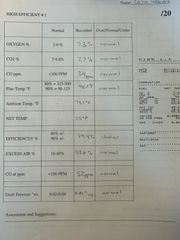
:) |
|
|
What would perfect combustion be? |
Perfect is 12% CO2 ————- Complete is what we get: Air (8N + 2O2) + (Nat Gas (CH4)) => 8N + water (2 H2O) + carbon dioxide (C02) ——————- Incomplete:
Air (12N + 3O2) + (Nat Gas (2CH4)) => 12N + water (4H2O) + carbon dioxide (C02) + 2CO + C -Extra carbon and soot -The water stays the same —————- |
|
|
How much excess air? |
20% air for complete combustion |
|
|
Eff on print out? |

Steady state efficiency CO air free is removing excess air that is diluting exhaust Flue temp is important O2% is important CO2% is important Learn how to read these tickets. |
|
|
Eff on print out? |

Steady state efficiency CO air free is removing excess air that is diluting exhaust Flue temp is important O2% is important CO2% is important |
|
|
Turn on analyzer in space with furnace? |
True, Where ever the air temperature is for combustion that is where you turn your combustion analyzer on |
|

What is this chart? |
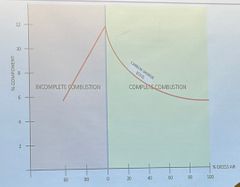
Left hand (x axis) side is % CO and the bottom (y-axis) is % oxygen
You want to be on the right side of the perfect combustion line After perfect combustion, we add more excess air so we dilute the carbon dioxide so CO2 dilutes… 12% is needed for complete combustion |
|
|
7% oxygen and 7% CO2 is good? What if you have no oxgen? |
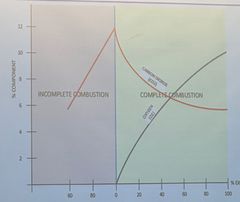
If you are on the incomplete combustion side there will be no oxygen.
0% oxygen and 7% CO2 is bad |
|
|
What are good numbers for CO and O2 |
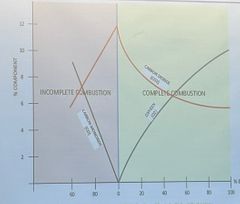
7-9.8% CO2 3-9% 02 |
|
|
What happens to the natural gas line on the incomplete side of the graph? |
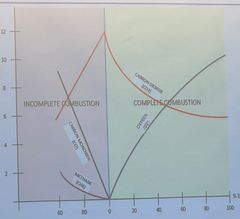
It lowers as it goes towards complete combustion |
|
|
TQ: Acetylene working pressure? |
TQ: 200 psi drops it down to 15 psi |
|
|
TQ: Acetylene working pressure? |
TQ: 200 psi drops it down to 15 psi |
|
|
TQ: Roof top unit needs what between the curb and rooftop unit? |
Gasket |
|
|
Incomplete combustion produces? |
CO, rust around rims of draft hood, aldehydes |
|
|
What are some common combustion ratings? |
Combustion Ratings • Input/Output method: MFGs Input / Output • Combustion Efficiency: Usable heat energy at a specific time • Theoretical heat value of the fuel minus the stack losses • Reasonable estimation of Thermal efficiency • Steady-State Efficiency (SSE): Calculated only when combustion is within manufacturers specifications • Thermal efficiency: How effectively the heat exchanger removes the heat from the burned fuel • Annual Fuel Utilization Efficiency (AFUE): Seasonal Efficiency True appliance efficiency using Standby losses, Combustion efficiency and Thermal efficiency losses over a year |
|
|
Where to take your combustion analysis? |
On ALL EQUIPMENT: Take combustion analysis before draft air is added. Stick a copper tube on your analyzer and stick it in. Midefficient: drill a hole into the exhaust vent |
|
|
Formula for approximate excess air? |
%O2 x 5 = Excess air (%) %10 x 5 = 50% %O2 |
|
|
Approximate Excess Air given CO%? |
Analysis Numbers CO2 • CO2 = Percentage of Carbon Dioxide in combustion gas • Ultimate CO2 is 12% (Stoichiometric) • Concentrations should be between 7-9.8% • Approximate Excess Air = ((12 - CO2%) × 90) / CO2% |
|
|
What is a bad PPM for CO? |
If it is over 100 ppm then start looking into issues ——————————- Slide says some stuff that apprently is wrong. Max doesnt matter. • CO = Percentage of Carbon Monoxide in combustion gas • Occurs from incomplete combustion • Concentrations should be less than 100 PM • Max allowed: • 400 PPM (furnace) • 800 PPM (oven) • Check flame pattern upon blower startup for indication of cracked heat exchanger |
|
|
TQ 4000 ppm is death in minutes? TQ 50 ppm max for 8 hours? |
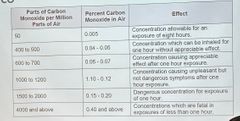
Yup Apparently you need to known the decimal number too!
|
|
|
What is too much excess air? |
Excess Air • Air in excess of required combustion air • Too much Excess air lowers flue gas temp lowering combustion efficiency and potentially causing CO forming • Reducing Excess air causes hotter flames • Typical amounts: • Atmospheric - 40% • High Efficient - 10-60% (the lower the better) • Many pieces of equipment can not have air adjusted |
|
|
TQ: what are the losses on a system? |
Losses • Efficiency lost through flue gasses • Losses = 100% - Efficiency% • 90.2% eff system would have 9.8% Losses through the stack |
|
|
What is a common flue vent pressure? |
Draft • Checked using a draft pressure gauge • Excessive vent draft indicates: Indicates overfired appliance Air adjustment open too far • Low vent draft indicates: underfired, heated medium velocity too high flue gas temps too low, building pressure too low • Typical: Atmospheric -0.02" wc to -0.04" wC
High eff 0.02" wc to 0.04" wC |
|
|
What temp do flue gases condense? |
126F
Flue Temp • Often referred to as Stack Temperature • Temp of the combustion gases exiting the appliance • Measured with a Pyrometer • Indicates how much heat is not being used • Typical Non-condensing temp 325F to 500F • Typical Condensing temp 90-125F (Below 126F) |
|
|
How do you calculate efficiency? |
Net Flue Temp . Calculated by subtracting the Ambient temp from the actual flue gas temp • Used to calculate the appliance combustion efficiency with a nomograph Net Temp = =Stack Temp - Ambient Then use your chart |
|
|
TQ: How do you use the chart |
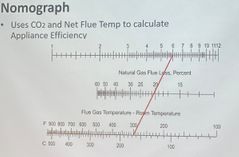
Get CO% (6%) Get (flue gas temp - room temp) (370-70 = 300F) So, draw a line and you get 20% losses 100% - 20% = 80% |
|
|
What are the exprected values for a combustion analysis? |
:) |
|
|
When setting up an amp meter without auto range what should be done? |
Set to the highest scale |
|
|
What rots out heat exchangers? |
Underfire |
|
|
Under fired heat exchangers can get what type of damage? |
Corrosion |
|
|
What is a wintergreen test? |
A heat exchanger test Sulphur test, smoke test, water test |
|
|
Is rocking back and forth for a PWM motor normal? |
Yes |
|
|
When will you get a cracked heat exchanger? |
Overfired |
|
|
TQ: what is the most important factor when dealing with an apprentice? |
Safety! |
|
|
TQ: What would happen if you increase the orific size? |
Over fired |
|
|
Will you get lift off if you increase the size of the inducer motor? |
You can get flash back if you have way too much air. |
|
|
400 ppm is for oil burning and you must turn it off. ILM? |
True |
|
|
Too much excess air…. |
Lower efficiency |
|
|
Atmospheric burners require secondary air? |
True |
|
|
Dilution air is added to… |
Promote stack effect and cool combustion air |
|
|
Net flue gas is taken from… |
Temperature entering combustion process |
|
|
Net flue gas is taken from… |
Temperature entering combustion process |
|
|
Net flue and CO2 measurements for…. |
Nomograph |
|
|
Heating systems are most efficient at… |
High fire |
|
|
CO2 should be higher than O2 on the print out? |
True, if O2 is higher than CO2 then…
Add gas pressure |
|
|
What would cause the flame to float? |
Negative pressure in the furnace room |
|
|
ECM motor rocks on start up? |
This is normal |
|
|
Wire for grounding is Green or Green and yellow? |
True |
|
|
Highest category of electrical panel? |
4 |
|
|
Combustion analyser is Steady state efficiency |
SSE |
|
|
Things I didnt study |
Flame failure responce time Where is high limit in an mua |
|
|
What do I need to study for the lab final? |
Pipe size per distance Gas tight Pressure drop across a valve 100V on the flame sensor Sequence of operation |

